El bordado a mano es una hermosa habilidad para aprender y dominar porque es versátil.. Ya sea cosiendo por lágrimas o recogiendo una aguja por primera vez, you’;Asegúrese de adquirir nuevas habilidades y técnicas de nuestro artículo Bordado para principiantes.! Bordar es tan sencillo como dibujar sobre un trozo de tela y luego coserlo., pero el tipo y la forma de los diferentes puntos utilizados es la habilidad que marca la diferencia.. We’;Exploraremos el bordado a mano paso a paso., y le mostraremos cómo usar la puntada de bordado para que sus puntadas luzcan prolijas y uniformes..
We’;Te guiaremos a través de los diferentes tipos de puntadas de bordado a mano y cómo trabajarlas., as well as feature a great selection of hand embroidery patterns for beginners that you’;Los encontraremos reunidos aquí.. Voluntad! If you’;Nunca antes había cogido una aguja., o simplemente quieres un repaso, Sigue leyendo para aprender a bordar aros para principiantes..
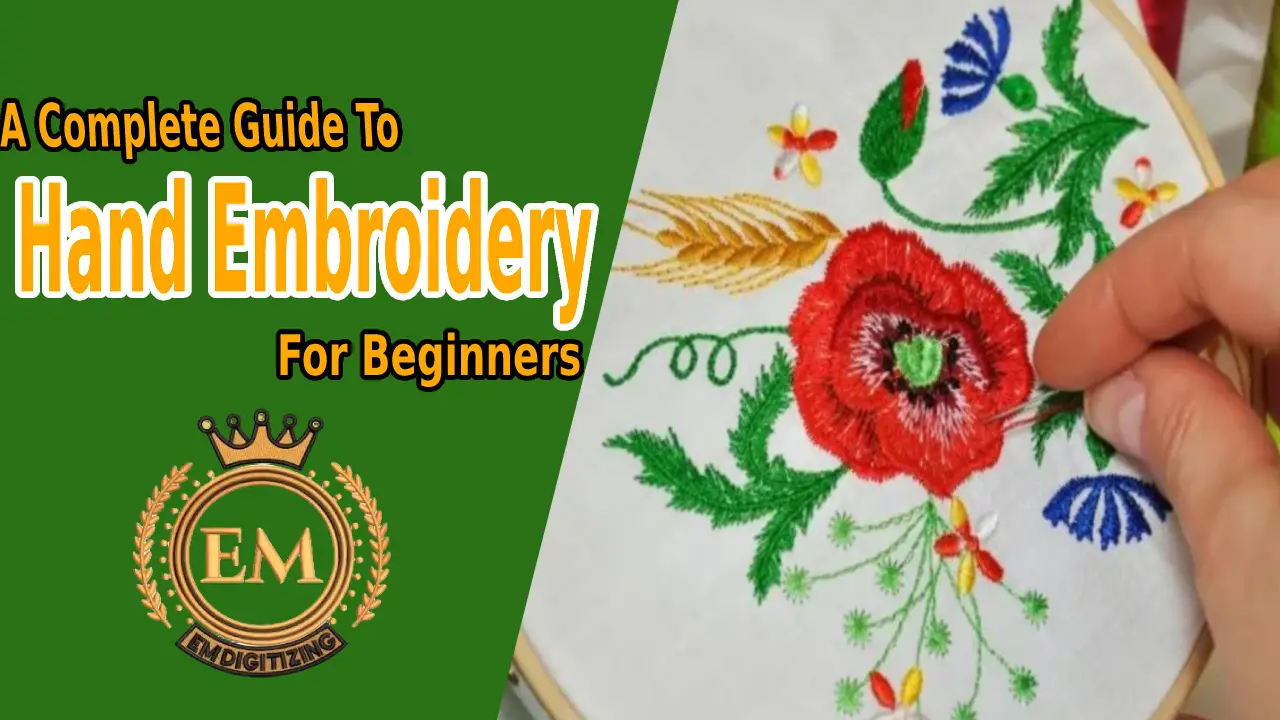
Servicios de digitalización de bordados
Conceptos básicos de bordado para principiantes
Ninguna guía de bordado está completa sin los elementos esenciales que necesitas para comenzar.. Luckily you don’;No necesitas mucho para hacer tu propio kit de inicio de bordado..
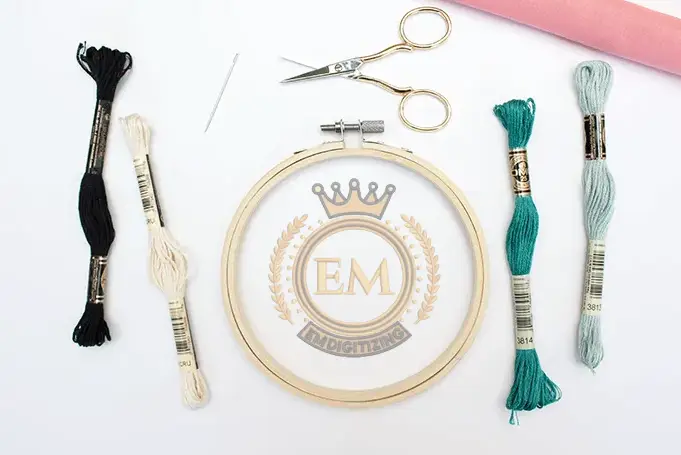
la aguja
Agujas de bordar tener un ojo largo que facilita el enhebrado si cose con varios hilos. Elige tallas 7 y 9 para bordar ya que son adecuados para coser a mano.
La tela
It’;s best to sew on a closely woven fabric so that your stitches don’;No desaparece entre los hilos de la tela.. El algodón y el lino son ideales.. Las manualidades del amor tienen una buena variedad de telas bordadas para empezar.
El hilo
Hay muchos hilos diferentes que puedes usar, pero el algodón trenzado es el más común.. Cada hilo tiene seis hebras por largo, por lo que puedes variar dependiendo del grosor que quieras que tengan los puntos..
Hay muchos hilos diferentes que puedes usar, pero el algodón trenzado es el más común.. Cada longitud de hilo Tiene seis hilos para que puedas usar diferentes números dependiendo del grosor que quieras que tengan los puntos..
Aro de bordado
If you haven’;No los usé antes, Los aros son económicos pero esenciales para mantener la tela agradable y cómoda mientras coses.. Sin uno, puede ser muy difícil no tirar demasiado al coser., que puede hacer que la tela se rompa.
Tijeras para bordar
Las tijeras para bordar son más pequeñas que las tijeras promedio y tienen hojas afiladas que se enganchan fácilmente hilos. Vienen en diseños atractivos y clásicos y se convertirán en una de las herramientas más utilizadas de su kit..
Tipos de puntadas de bordado a mano
Pespunte
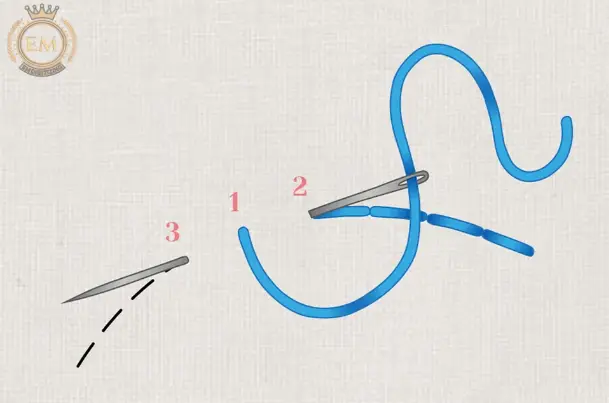
Utilice pespuntes para un contorno limpio. Lleva la aguja hacia arriba y hacia atrás sobre la tela., como se muestra. Empuja la aguja hacia atrás frente a donde empezaste., asegurándose de mantener todos los puntos limpios y uniformes.
Puntada de satén
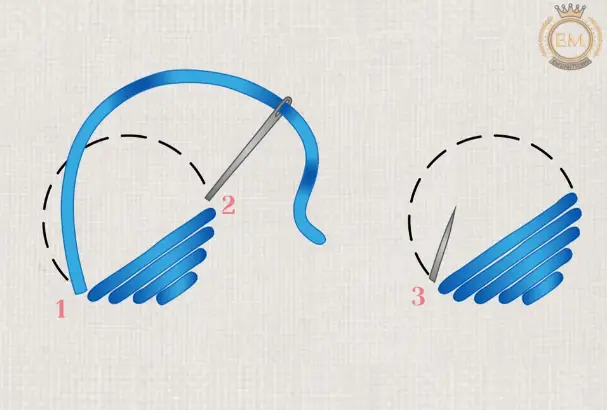
Para trabajar punto satinado, llevar la aguja hasta 1 en un lado de la forma y luego hacia abajo hasta 2 allende. Continúe cosiendo de esta manera para que todos los puntos queden juntos sin que se vea nada de la tela..
puntada de tallo
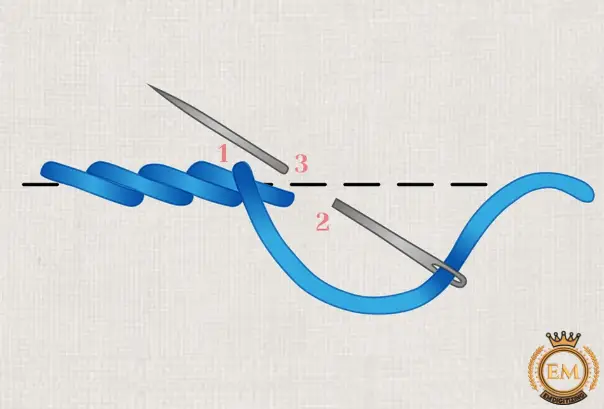
Cosa de izquierda a derecha con pequeños puntos regulares a lo largo de la línea del diseño. Para coser tallos, El hilo siempre debe salir por la izquierda del punto anterior.. La puntada de tallo se utiliza para tallos de flores., contornos, etc..
Puntada de margarita perezosa
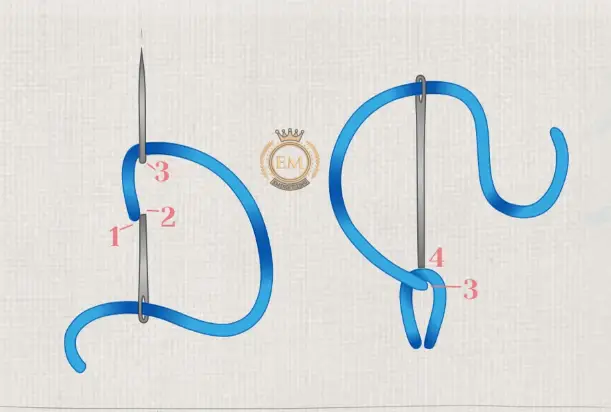
Sostenga la aguja hacia arriba en 1 y abajo en 2, sin pasar la aguja por toda la tela. Vuelva a colocar la aguja en 3 o’;reloj con el hilo debajo de la aguja, y tire suavemente para formar un bucle. Asegure el bucle empujando la aguja hacia adentro en el otro lado del bucle..
Nudos Coloniales
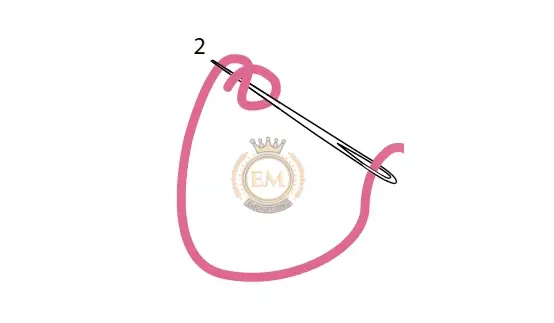
Lleva la aguja a 1 y enrollar el hilo sobre él. Luego pase el hilo hacia arriba y hacia abajo por la aguja en forma de ocho.. Siga la ruta del hilo en el diagrama para ver cómo sucede esto.. Empuje la aguja hacia abajo en 2, cerca de donde surgió por primera vez. Antes de tirarlo hasta el final constantemente, Apriete los bucles alrededor de la aguja y manténgalos en su lugar.. Tira de la aguja para formar un nudo limpio..
Puntada de rueda tejida
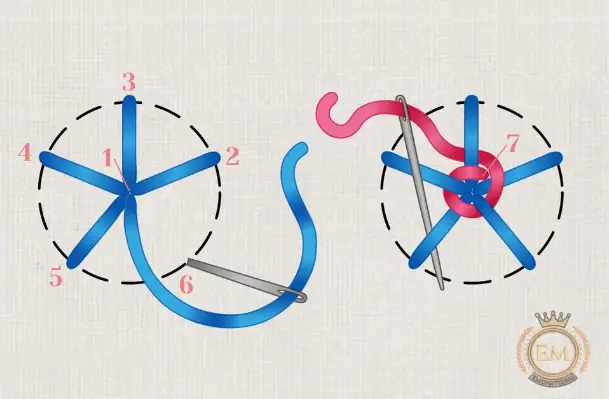
Haga cinco puntos rectos espaciados uniformemente en un círculo como se muestra. Ahora, Lleve la aguja al centro donde se unen todos los puntos rectos.. Cóselo alternativamente por debajo y por encima de los puntos rectos., making sure you don’;t coser a través de la tela o las puntadas. Continúe hasta haber tejido el hilo recto hasta los extremos exteriores de los puntos., luego mueva la aguja hacia atrás para terminar.
puntada corriente
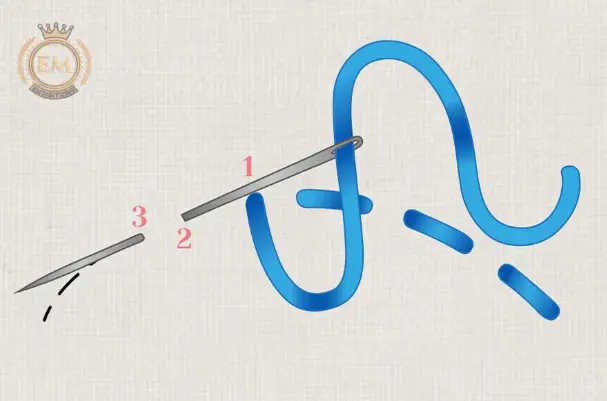
Mueva la aguja hacia arriba y hacia abajo en la tela para hacer puntadas de longitud regular.. Asegúrese de que todos los puntos tengan la misma longitud y que los espacios que quedan entre ellos tengan la misma longitud para obtener una puntada ordenada.. Mantenga la tensión para que las puntadas queden prolijas sobre la tela..
Tutorial completo de bordado a mano: Paso a paso
Paso No. 1
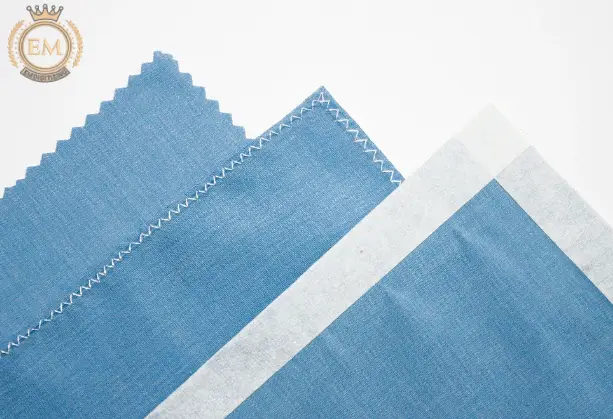
Prepara tu tela para evitar que se deshilache. Hay muchas maneras de hacer esto.. Para una solución rápida, sellar los bordes con cinta adhesiva, o puedes recortar alrededor del borde con unas tijeras dentadas.. Para el acabado más seguro, use una máquina de coser para hacer una puntada rápida en zigzag alrededor de los bordes.
Paso No. 2
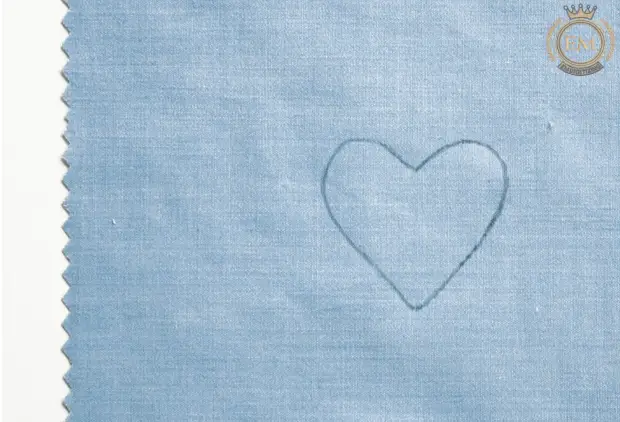
Mueva el diseño. La mayoría de los proyectos de bordado utilizan plantillas., que necesitarás transferir a tu tela. La forma sencilla y fácil es localizarlo.. Coloque la tela con el lado derecho hacia arriba sobre la plantilla y asegúrela con cinta adhesiva.. usando un lapiz, pluma soluble en agua, o tiza, traza todas las líneas del color que aparecerá en la tela. Si te cuesta ver el diseño a través de la tela, luego pegue el diseño y la tela a la ventana. La luz brillará para que puedas ver y trazar el diseño como antes..
Paso No. 3
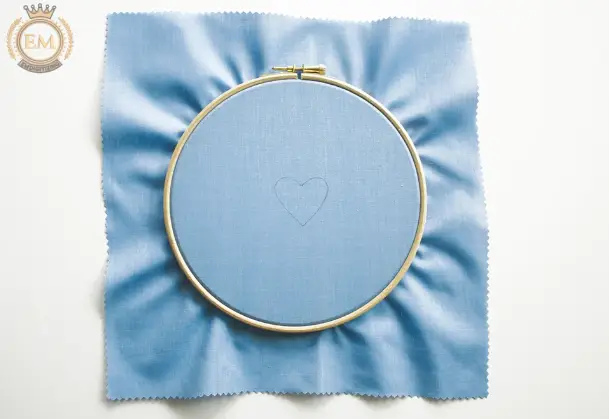
Once you’;He trazado tu diseño, colocar la tela en un aro o marco. Esto proporcionará la tensión adecuada y tus puntadas quedarán prolijas..
Paso No. 4
La forma más sencilla de empezar es con un nudo inactivo.. Anuda un extremo del hilo y bájalo por el frente de la tela., acerca de 2.5 cm (1 pulgada) desde tu punto de partida. Vuelve a subirlo para crear tu primera puntada.. Comienza a coser tu diseño., asegurándote de coser en el hilo inicial. Una vez que su hilo inicial esté seguro, simplemente corta el nudo. Si estás cosiendo con 2 hebras de hilo, También puedes probar con un nudo en bucle para lograr un acabado más prolijo..
Paso No. 5
Ahora trabajas alrededor del diseño que has trazado realizando una serie de pequeños puntos de bordado..
Paso No. 6
To secure the thread when you’;terminamos de coser, tejerlo a través de la parte posterior de tu puntada.
Cómo terminar el bordado
Cómo lavar el bordado
Lavar la ropa después de coser realmente le dará vida a tu bordado y también restaurará la frescura del algodón o el lino.. Remoje la tela cosida en un recipiente con agua tibia con un poco de jabón suave durante aproximadamente 15 minutos, luego sacúdalo suavemente. Para eliminar marcas, esponja con cuidado, teniendo cuidado de no alterar los puntos si es posible. Enjuague bien y enrolle el punto en una toalla para exprimir el exceso de agua.. Dejar secar en plano.
Cómo presionar el bordado
Si has lavado tu tela, Lo mejor es planchar la tela mientras aún está ligeramente húmeda.. Ante todo, Rellena tu tabla de planchar con una toalla gruesa.. Coloque su trabajo con el lado derecho hacia abajo sobre una fina, paño limpio. Presione con cuidado hasta que la tela esté seca.. La toalla evitará que la plancha aplaste los puntos.. Presiona suavemente la punta de la plancha en los puntos mientras los trabajas..
Conclusión
Estoy seguro de que este artículo te ayudará a entender el bordado a mano.. Y conozca también sobre los tipos de bordado a mano y el paso a paso del trabajo del bordado a mano.. Espero que esto les ayude chicos!
Puntada corriente. Correr el punto es muy sencillo dentro y fuera del punto que quizás hayas aprendido cuando eras niño.. Para este diseño, estás trabajando una puntada circular desde el centro.
Por supuesto, puedes bordar a mano sin utilizar un aro.! Si bien es muy común utilizar un aro, ciertamente no es necesario.
Cuándo usar primero las puntadas de contorno A algunas personas les resulta útil hacer una puntada de contorno (es decir, una puntada corriente o una puntada trasera) antes de rellenar una puntada de bordado como una puntada de satén. Esta línea de puntos sirve como una especie de guía sobre dónde terminarán los bordes de los puntos..
6 puntos básicos de bordado
- Pespunte.
- Puntada corriente.
- Cadeneta.
- nudo francés.
- Puntada de margarita perezosa.
- Puntada satinada.
Para todos aquellos que se preguntan qué es más difícil, punto de cruz o bordado, la conclusión es esta: El punto de cruz es definitivamente más fácil que el bordado..
